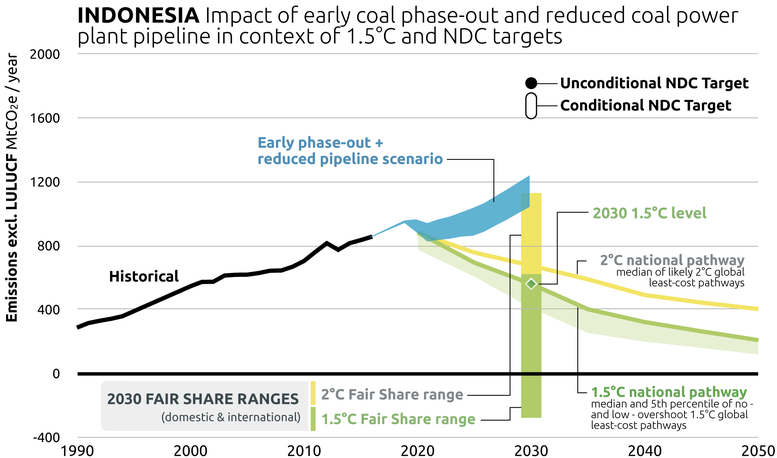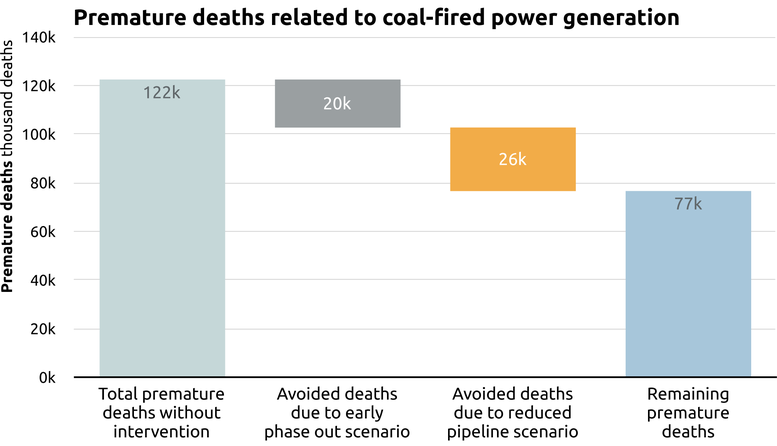How a COVID-19 recovery with less coal could benefit Indonesia
Attachments
Summary
Reassessing its reliance on coal for electricity would be an important step in Indonesia’s green recovery. In this analysis we model two options for Indonesia to reduce its planned coal-fired capacity, and the resulting impact on projected emissions, as well as the impact on premature deaths from air pollution.
We find that if Indonesia were to phase out coal-fired plants that have been in operation for over 20 years and reassesses portions of its coal-fired power plant pipeline, it could reduce emissions by 7-11% below current policies. This corresponds to emissions 30% below Indonesia’s current Paris Agreement Nationally Determined Contribution (NDC) emissions target. These measures provide opportunities for Indonesia to increase its target. They would also help Indonesia avoid over 45,000 premature deaths in the next decade (a reduction of almost 40%) by reducing its reliance on coal electricity.
The measures investigated in this analysis remain insufficient to align Indonesia’s current policies with a 1.5°C Paris compatible pathway. A much stronger uptake of renewable energy technologies and coal phase out are necessary to curb Indonesia’s emissions. The forthcoming electricity supply plan (RUPTL 2021-2030) provides a concrete opportunity to reassess the role of coal and put Indonesia on a pathway towards decarbonisation.
Effect of COVID-19 on greenhouse gas emissions
COVID-19 had a marked impact on Indonesian emissions, but Indonesia looks set to miss an opportunity to lock in deep emissions reductions as it recovers from the pandemic. Without additional measures, emissions are projected to remain on an upwards trend between 2020 and 2030.
The CAT estimates that Indonesia’s emissions decreased up to 6% in 2020 compared to 2019 due to the pandemic. The long-term effect of the pandemic or recovery measures is still unclear. Despite this uncertainty, emissions are projected to rebound after the short-term dip and increase approximately 33-39% between 2020 and 2030.
The importance of rethinking the role of coal in Indonesia
A global transition away from coal electricity is fundamental to achieving the goal of the Paris Agreement. Many countries plan to reduce their coal project pipeline. Indonesia’s plans to expand coal capacity are off track compared to action by other countries in the region. To scale climate change mitigation ambition in its power sector, Indonesia should revisit plans to build new coal power plants.
The effect of a reduction of coal-fired electricity on Indonesia’s emissions
An early phase out combined with a reduction in the existing pipeline could reduce emissions to 1,050-1,250 MtCO2e, which is 7-11% below current policies. This reduction remains insufficient to align Indonesia’s current policies with a 1.5°C Paris compatible pathway, which requires emissions to fall below 560 MtCO2e in 2030 (excluding LULUCF).
Re-evaluating coal dependency presents a huge potential to scale up the ambition of Indonesia’s NDC, which presents an unconditional, 2030 emissions target of 1,817 MtCO2e, excluding LULUCF. Indonesia is very likely to overachieve its 2030 Paris Agreement targets, excluding the forestry sector, with currently implemented policies, despite the lack of additional climate change mitigation measures . The current target is not in line with any interpretation of a “fair” approach to the Paris Agreement’s 1.5°C limit but Indonesia does not intend to update it before COP26.
Wider co-benefits of less coal for electricity generation in Indonesia
The implementation of an early phase out for old power plants and re-evaluation of the existing pipeline would also have spill over effects beyond mitigation. We quantify effects on premature deaths resulting from air pollution, and find that Indonesia could avoid over 45,000 premature deaths in the next decade (a reduction of almost 40%) by reducing its reliance on coal electricity.
A reduction in coal-fired electricity would have a positive effect on air pollution, reduce strain in the health system and help save thousands of lives. The operation of a coal-fired power plant leads to negative effects throughout the plant’s whole lifetime.
Stay informed
Subscribe to our newsletter


